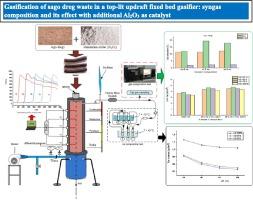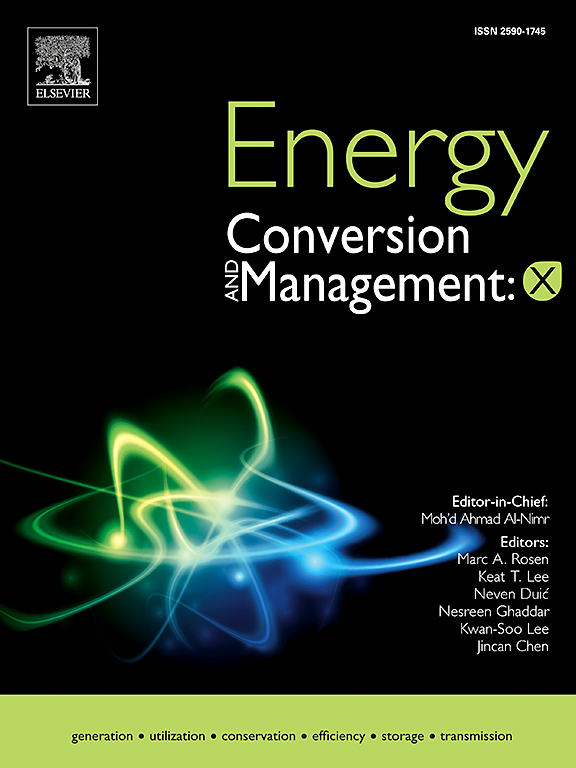在顶部升流固定床气化炉中气化西米渣废料:合成气成分及其对添加 Al2O3 催化剂的影响
IF 7.1
Q1 ENERGY & FUELS
引用次数: 0
摘要
西米食品已成为印度尼西亚东部的主食。作为一种副产品,西米废料具有用作可再生能源燃料的潜力。本研究旨在利用顶燃上行气流(TULD)固定床气化技术将西米废渣转化为可再生能源。Al2O3 是一种从粉煤灰中提取的潜在固体废弃物,目前也在研究其在西米渣颗粒中的应用。在涉及 TULD 反应器的气化过程中采用的操作参数,如气化温度、空气流速、空燃比 (AFR) 和合成气评估。结果表明,在西米渣颗粒中添加 Al2O3 作为催化剂可提高合成气产量(H2、CO 和 CH4)。最明显的变化是氢气(H2)的平均含量增加了,其中 5 % Al2O3 的增加幅度最大,为 31.65 %;10 % Al2O3 的增加幅度最大,为 29.94 %。同时,与不含 Al2O3 的西米果渣颗粒相比,10 % Al2O3 的 CO 和 CH4 气体含量最高,平均值也分别增加了(CO 4.33 % 和 CH4 26.45 %)。最后,使用 Al2O3 催化剂的西米渣颗粒作为内燃机替代能源燃料的潜力很大,焦油含量低的 5 % Al2O3 和 10 % Al2O3 的 H2/CO 分别为 1.65 和 1.51。本文章由计算机程序翻译,如有差异,请以英文原文为准。

Gasification of sago dreg waste in a top-lit updraft fixed bed gasifier: Syngas composition and its effect with additional Al2O3 as catalyst
Sago-based foods have become a staple food in eastern Indonesia. Sago waste, as a by-product, has the potential to be used as a renewable energy fuel. This research aims to use sago dregs waste as an energy source by converting it into renewable energy using Top Lit Updraft (TULD) fixed bed gasification. Al2O3, a potential solid waste derived from coal fly ash, is also being investigated for use in sago dreg pellets.The two various Al2O3 contents in sago dreg pellets that will be examined with 5 % Al2O3 and 10 % Al2O3. Operational parameters employed in the gasification process involving the TULD reactor, such as gasification temperature, air flow rate, air-to-fuel ratio (AFR), and syngas assessment. According to the results, adding Al2O3 as a catalyst to sago dreg pellets can improve syngas production (H2, CO, and CH4). The most significant alteration is that the average hydrogen gas (H2) content has increased, with the greatest being in 5 % Al2O3 with 31.65 %, and 10 % Al2O3 with 29.94 %. Meanwhile, the CO and CH4 gas content was found to be highest at 10 % Al2O3, with each experiencing an increase in average (CO 4.33 % and CH4 26.45 %) as compared to sago dregs pellets without Al2O3. Finally, sago dregs pellets with an Al2O3 catalyst have a high potential as an alternative energy fuel for internal combustion engines with H2/CO of 1.65 and 1.51 respectively, for 5 % Al2O3 and 10 % Al2O3, with low tar content.
求助全文
通过发布文献求助,成功后即可免费获取论文全文。
去求助
来源期刊

Energy Conversion and Management-X
Multiple-
CiteScore
8.80
自引率
3.20%
发文量
180
审稿时长
58 days
期刊介绍:
Energy Conversion and Management: X is the open access extension of the reputable journal Energy Conversion and Management, serving as a platform for interdisciplinary research on a wide array of critical energy subjects. The journal is dedicated to publishing original contributions and in-depth technical review articles that present groundbreaking research on topics spanning energy generation, utilization, conversion, storage, transmission, conservation, management, and sustainability.
The scope of Energy Conversion and Management: X encompasses various forms of energy, including mechanical, thermal, nuclear, chemical, electromagnetic, magnetic, and electric energy. It addresses all known energy resources, highlighting both conventional sources like fossil fuels and nuclear power, as well as renewable resources such as solar, biomass, hydro, wind, geothermal, and ocean energy.
 求助内容:
求助内容: 应助结果提醒方式:
应助结果提醒方式:


